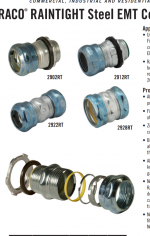firebird1988
Member
- Location
- Arkansas
- Occupation
- Solar
So, Working on a client project. I have a wire trough outside. A Double Throw Safety Switch will be installed above with a outdoor rated breaker panel. Part number DT223URH-NP on the double throw safety switch.
The wire through will have zero splices or lived components. my understanding is that I need rain tight fittings and was going use Myers hub.
Sigma ProConnex™ 2" Rigid Insulated Raintight Hub
Model Number: 02-54075.
Now am I wasting clients' money trying to make it waterproof even tho there is zero splices or lived components inside this wire trough? Now on the backside of the wire trough will entry into the house which will have live components with same level of the wire trough but that pipe will be sealed with duck putty.
The wire through will have zero splices or lived components. my understanding is that I need rain tight fittings and was going use Myers hub.
Sigma ProConnex™ 2" Rigid Insulated Raintight Hub
Model Number: 02-54075.
Now am I wasting clients' money trying to make it waterproof even tho there is zero splices or lived components inside this wire trough? Now on the backside of the wire trough will entry into the house which will have live components with same level of the wire trough but that pipe will be sealed with duck putty.



